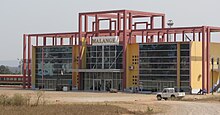Malanje
History
Portuguese rule
Portuguese settlers founded Malanje in the 19th century. The construction of the railway from Luanda to Malanje, in the fertile highlands, started in 1885. The area around Malanje included Portuguese West Africa's primary areas dedicated to the production of cotton, the crop that drove its development since the beginning. The town developed in the mid-19th century as an important slave market created in 1852. Situated at an elevation of 1,134 metres (3,720 ft), the town has a high-altitude tropical climate, ideal to several agricultural productions. The city developed as an important agricultural, manufacturing, trading and services centre. Its productions included cotton, textiles, coffee, fruit and corn. The Cangandala National Park was established by the Portuguese authorities in 1970, having previously been classified as an Integral Natural Reserve in 1963.
After independence from Portugal
The withdrawal of the Portuguese in conjunction with Angola's independence in 1975, and, later, the Angolan Civil War (1975–2002), severely hampered the production of cotton as well as that of coffee and corn (maize). Malanje was partially destroyed during the civil war, but reconstruction efforts in the years following the end of the conflict have rebuilt the city and its surroundings.
Climate
Malanje has a tropical savanna climate (Koppen: Aw).
| Climate data for Malanje | |||||||||||||
|---|---|---|---|---|---|---|---|---|---|---|---|---|---|
| Month | Jan | Feb | Mar | Apr | May | Jun | Jul | Aug | Sep | Oct | Nov | Dec | Year |
| Record high °C (°F) | 32 (90) |
33 (91) |
32 (90) |
31 (88) |
31 (88) |
31 (88) |
32 (90) |
33 (91) |
32 (90) |
32 (90) |
31 (88) |
31 (88) |
33 (91) |
| Mean daily maximum °C (°F) | 27 (81) |
27 (81) |
28 (82) |
27 (81) |
29 (84) |
28 (82) |
29 (84) |
30 (86) |
29 (84) |
28 (82) |
27 (81) |
27 (81) |
28 (82) |
| Daily mean °C (°F) | 21 (70) |
21 (70) |
22 (72) |
21 (70) |
21 (70) |
18 (64) |
19 (66) |
21 (70) |
22 (72) |
22 (72) |
21 (70) |
21 (70) |
21 (70) |
| Mean daily minimum °C (°F) | 16 (61) |
16 (61) |
16 (61) |
16 (61) |
13 (55) |
9 (48) |
9 (48) |
12 (54) |
15 (59) |
16 (61) |
16 (61) |
16 (61) |
14 (57) |
| Record low °C (°F) | 13 (55) |
11 (52) |
8 (46) |
11 (52) |
4 (39) |
4 (39) |
2 (36) |
5 (41) |
10 (50) |
12 (54) |
11 (52) |
11 (52) |
2 (36) |
| Average precipitation mm (inches) | 80 (3.1) |
130 (5.1) |
190 (7.5) |
160 (6.3) |
10 (0.4) |
0 (0) |
0 (0) |
0 (0) |
50 (2.0) |
120 (4.7) |
200 (7.9) |
140 (5.5) |
1,130 (44.5) |
| Source: weatherbase.com | |||||||||||||
Landmarks
Near the city is the Cangandala National Park, established by the Portuguese authorities on 25 June 1970, it was founded to protect the Giant Sable Antelope which were discovered in 1963. As far as religious buildings are concerned, there is the Evangelical Church at Quêssua and as for funerary constructions, the Tomb of the queen Ana de Sousa Nzinga Mbande and the tomb of José do Telhado, a local Robin Hood. José do Telhado was a Portuguese who was exiled to Portuguese Angola that in colonial days used to steal from rich whites and distribute to poor blacks. Worth visiting is the Forte de Cabatuquila in the city.
Transportation

Airport
Malanje Airport was built during the colonial era. Currently, there are no flights to the capital Luanda.
Railway
The construction of the railway from Luanda to Malanje, in the fertile highlands, started in 1885. After the end of the civil war in 2002, it was expected to be the terminus of a railway from the capital city and port of Luanda once reconstruction was complete.
See also
References
- ^ Citypopulation.de Population of provinces and municipalities in Angola
- ^ Citypopulation.de Population of the major cities in Angola
- ^ "Ranked: The World's Fastest Growing Cities". virtual capitalist. Archived from the original on 13 August 2021. Retrieved 2021-08-17.
- ^ "História económico-social de Angola: do período pré-colonial à independência" (PDF). University of Porto (in Portuguese). Retrieved 16 December 2021.
- ^ "Geographic coordinates of Malanje, Angola". dateandtime.info. dateandtime.info. 2015. Retrieved 7 September 2015.
- ^ "Weatherbase: Historical weather for Malange, Angola". Retrieved June 18, 2019.